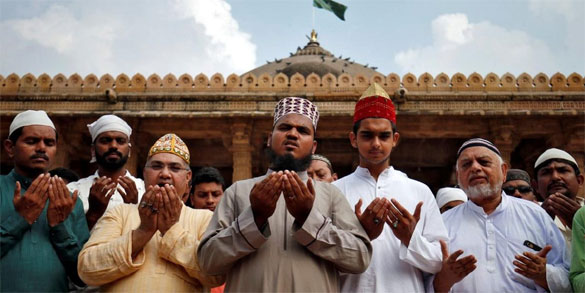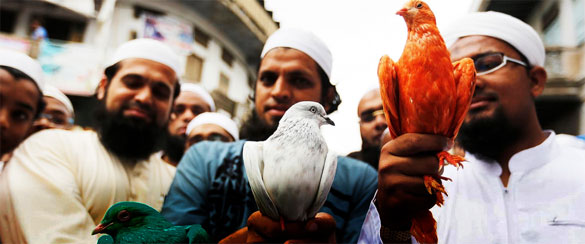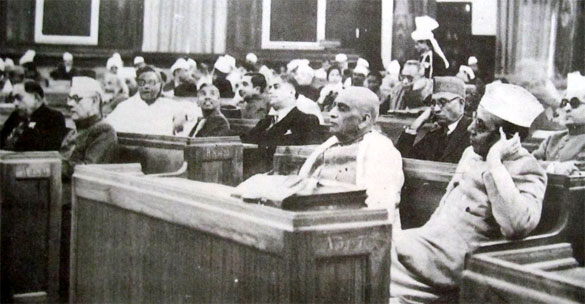While Hindu Shudras And Dalits Enjoy The Protection Of Reservation; Muslim Ajlaf Or Arzal Does Not
By Pratik Patnaik
4 December
2020
Traditionally,
it is understood that Abrahamic religions, including Islam, are egalitarian and
do not advocate caste or any other form of stratification. Scholars often cite
Prophet Muhammad’s farewell Khutbah where he had famously said, “There is no
superiority of an Arab over a non-Arab, or of a non-Arab over an Arab, and no
superiority of a white person over a black person or of a black person over a
white person, except on the basis of personal piety and righteousness.”

Representative image of
Muslims praying inside a mosque in Ahmedabad, November 8, 2019. Photo:
Reuters/Amit Dave
------
The story
of an Ethiopian slave Bilal, who became the first muezzin of the Islamic world
because of his beautiful voice and piety, is also cited to buttress the
argument. While it is true that discrimination cannot be traced back to
Abrahamic scriptures, as in the case of Hinduism, the existence of caste
amongst South Asians (irrespective of their religion) is unfortunately a
repugnant truth.
Not A Hindu Problem Alone
Most
Indians understand caste as a Hindu problem, I was no different. Years ago,
while reading Twilight in Delhi, a much-celebrated novel by Ahmed Ali on Purani
Dilli (Old Delhi), the reality of Brahmanism in Islam (referred to as ‘Syedism’
in the Islamic context) was unloaded on me like a ton of bricks. One of the
major characters, Asghar falls in love with Bilqeece, a girl belonging to a
lower caste. Asghar’s father Mir Nihal, a self-identified Ashrafi (a higher
caste), strictly warns him never to think of marriage with a girl from a lower
caste as it is against their social dignity.
What was
this caste business being spoken of in a Muslim household? I embarked upon a
journey to study vertical casteism in non-Indic religions, which finally
culminated in this piece.
A Clear Stratification
Indian
Muslims are stratified into three main castes. At the top of the pyramid are
the Ashrafs (literally, the ‘nobles’, who trace their ancestry to inhabitants
of the Arab peninsula or Central Asia or are converts from Hindu upper castes),
Ajlafs (literally, the ‘commoners’, who are said to be converted from Hindu low
castes) and Arzals (literally, the ‘despicable’, who are said to be Dalit
converts).
In short,
Ashrafs are the Brahmin equivalent, Ajlafs are the Vaisya equivalent and
Shudras, and Arzals are the Atishudras or Dalit equivalents of Islam.

Muslims hold pigeons during a
march to celebrate India’s Independence Day in Ahmedabad, India, August 15,
2016. Credit: Reuters
-----
The Hindu
Dalits and the Muslim Ajlafs/Arzals are, as they say, united in common grief.
Both, the Sachar Committee Report and the Ranganath Mishra Committee Report
have brought to light several abuses and discriminations that an average Muslim
Ajlaf/Arzal face every day, including social segregation, untouchability,
limited or no access to education, and underrepresentation. The old Bahujan
movement’s slogan ‘Dalit-pichda eksaman, Hindu ho ya Musalman’ stands
vindicated by these reports.
A Colonial Hangover
It was the
Census of India, 1901, for the first time, officially recognised such
stratification amongst Muslims, listing 133 social groups wholly or partially
Muslims. The 1911 Census listed some 102 caste groups among Muslims in Uttar
Pradesh, wherein at least 97 of them came from the non-Ashraf category. The
term ‘Scheduled Caste’ was coined by the government of India (Scheduled Caste)
Order, 1936 (hereafter 1936 Order) to refer to those groups that were known as
“depressed classes” till then.
After
throwing off the British yoke, the Indian legislators crystallised the concept
of ‘scheduled caste’ by way of Constitution (Scheduled Castes) Order No. 19 of
1950, (hereafter 1950 Order). It is pertinent to note that both the 1936 Order
(latently) and 1950 Order (patently) made the assumption that caste was unique
to the Hindus.
In fact,
the 1950 Order, in its Paragraph 3, expressly sets out, “Notwithstanding
anything contained in paragraph 2, no person who professes a religion different
from the Hindu [the Sikh or the Buddhist] religion shall be deemed to be a
member of a Scheduled Caste.” This essentially means that barring Hindus, Sikhs
and Buddhists, no person practising any other religion can claim to be a
‘scheduled caste’ and consequently, the benefits thereof.
Nothing can
be farther from the truth. Both Ajlafs and Arzals share the same morose
predicament with their Hindu counterparts, the Dalits. As aforementioned, this
assertion has also been attested by the Sachar Committee and the Ranganath
Mishra Committee, both of which, in fact, recommended that certain caste groups
amongst the Muslims be given the status of ‘scheduled castes’.
Though
certain Muslim castes are recognised as Other Backward Classes (OBC) under the
27% quota, the disability, however, that they suffer due to the 1950 Order
cannot be redeemed by this consolation prize. The ‘Schedule Caste’ status is
amenable to a higher degree of affirmative action by the government, because of
the constitutional promises of reservations.
While both
classes of persons, the OBC and the Scheduled Caste, enjoy reservations in
educational institutions, jobs, etc., reservation of electoral constituencies is
only available to Scheduled Castes, who get the protection of the Scheduled
Caste and Scheduled Tribe (Prevention of Atrocities) Act, 1989, which OBCs do
not enjoy.
The net
result of this is while the Hindu Shudras and Dalits enjoy the protection of
the above, a Muslim Ajlaf or Arzal who goes through the same struggles and
faces the same discrimination, or even worse because of the additional
incidence of being a Muslim, is not given similar protection.
Of Laws And Prophets
The records
of the Constituent Assembly show that the founding fathers also worked under
the assumption that non-Hindus are somehow insulated from caste hierarchies.
The raging debate of the time was limited to separate electorates for Muslims
and their inclusion in the concept of ‘backward classes’ (which later came to
be known as OBCs).
The Supreme
Court and various high courts have been relatively more receptive than other
constitutional wings on the issue, they have remained non-committal
nonetheless. The jurisprudence of the constitutional courts may be divided into
two distinct phases.

The first day of the
Constituent Assembly of India. Photo: Wikimedia Commons
------
In the
first phase, the constitutional courts held that an individual’s caste would
entirely cease to exist upon conversion to a religion like Islam, as non-Indic
religions like Christianity and Islam do not recognise the caste system.
Consequently, the protection and affirmative actions in relation to Scheduled
Castes will not apply to them. This jurisprudence saw a tectonic shift in the
1970s when the Supreme Court in Arumugam v. S Rajgopal adopted a distinct
interpretation of vertical caste and ruled that caste does not cease but is
“eclipsed” upon conversion. With Arumugam (supra), the test for “retaining”
caste after conversion became a question of “fact”.
However,
all of this jurisprudence came from individual claims by people wanting to
retain their caste after conversion. No one had challenged the
constitutionality of the policy of excluding the non-Hindus itself. The only
available pronouncement on the issue of the constitutionality of the 1950 Order
was in Soosai v. Union of India in 1985.
In this
judgment, the Supreme Court accepted that the caste continued even after
conversion. It, however, sought for more material to show that the handicaps of
persons of Scheduled Castes had remained the same even after conversion to
Christianity. In Soosai (supra), the Court was not satisfied with the material
placed before it. Accordingly, the Supreme Court decided in favour of
constitutionality.
Bettering the Soosai judgement
In the
post-Soosai (supra) era, several petitions have been pending before the Supreme
Court, dating as far back as 2004, which have challenged the constitutionality
of the 1950 Order. The Chief Justice of India Sharad Arvind Bobde in January
2020 made observations that the social exclusion of Christians and Muslims from
the Scheduled Caste requires consideration.
It is to be
noted that Soosai (supra) was not a constitutional bench judgement, and the pending
petitions present themselves as a marvellous opportunity for the Supreme Court
to correct the historical wrong which could prove to be a watershed moment in
the rights-based jurisprudence of India.
The core
question before the Supreme Court would be whether the 1950 Order is offensive
to the principles of equality under Article 14 of the constitution, failing the
test of reasonable classification, as it creates two groups, being Hindu, Sikhs
and Buddhists as one integrated group, and others, for the purposes of
affirmative action and without having intelligible reasoning for doing so (as
even Muslims and Christians also face similar caste-based discrimination). The
question of justice for Dalit Muslims is a test case for the Indian
constitution’s proclaimed ideals of equality.
Gandhi
extolled Dalits with the expression ‘Harijans’ (god’s people). He had clearly
missed out on their Muslim counterparts. Jawaharlal Nehru had said, “We are
little men serving great causes, but because the cause is great something of
that greatness falls upon us also.” Justice Bobde’s court will serve a great
cause if they can reverse this injustice. In doing so, it will make better the
Constituent Assembly, Soosai and Gandhi great too.
-----
Pratik Patnaik is a
lawyer and policy commentator based in New Delhi.
Original Headline: Caste Among Indian Muslims
Is a Real Issue. So Why Deny Them Reservation?
Source: The Wire
URL: https://newageislam.com/islam-politics/while-hindu-shudras-dalits-enjoy/d/123659
New Age Islam, Islam Online, Islamic
Website, African Muslim News, Arab World News, South Asia News, Indian Muslim News, World Muslim News, Women in Islam, Islamic Feminism, Arab Women, Women In Arab, Islamophobia in America, Muslim Women in West, Islam Women and Feminism
